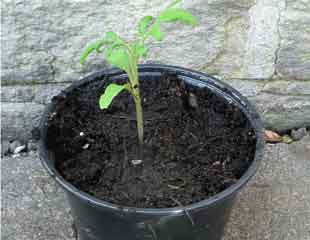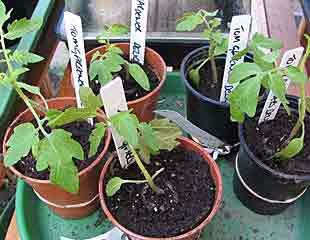
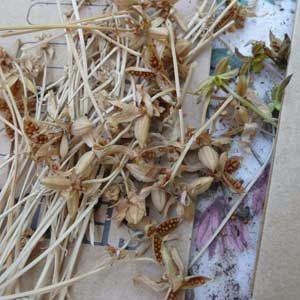
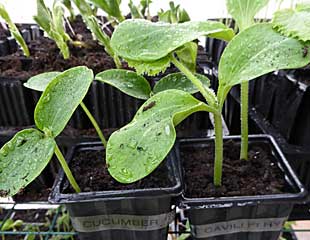
How to Sow and Germinate seeds

Using seed is an easy and cheap way to grow your own flowers and veg. If you are growing vegetables from seed, you can choose varieties you like and get a head start on the growing season.
To germinate and grow well, seeds need a controlled environment with as much light as possible. Light is as important as warmth and being in a frost free environment, which is why sowing early in the year is more difficult when light levels are low. If you sow in February/March, you will need somewhere frost free and warm for the seeds to grow on. An unheated greenhouse is likely to be too cold for the early seeds started in February.
It is a balance; sow too early and the seedlings may struggle and be leggy, so too late with some crops such as sweetcorn and tomatoes may just crop as Autumn arrives, especially if we have a bad summer or your garden is in an exposed area.
What can I sow now?
The first and often most difficult question especially for new gardeners is what to sow and when. You've lots of seeds and raring to get started, but the question is what can I sow now, and this is especially taxing for gardeners early in the year.
Almost all seeds need warmth, light and a sheltered environment to germinate, and then to grow.
This means if you are going to sow seeds early in the year, say February/ March, you need to provide all three, which means sowing indoors, often with heat to set off germination, in a propagator and with an ongoing warm environment. Even sowing inside, light levels are low and this is the real problem when you sow early. Low light levels often create poor seedlings and see below.
Light levels are important and there is a difference around the UK in the day length from North to South. For example, around 22.01. Poole on the South coast compared with Aberdeen has almost 1 hour more daylight, and although it's not a constant because of all the astrological complications, it is quite a surprising differential. In addition, just by delaying sowing from end of January to the end of February, the day will lengthen (based on London) by 1 hour 40 mins, which over a week is quite an increase in daylight.
In addition, there are regional variations for example areas of Wales, the Pennines, Scotland and the Moors of South West England can have annual rainfall exceeding 2000mm, whereas in contrast London has around 600mm. More rain equals more cloud cover and less light.
This means gardeners in the south of the UK and sunnier areas may get a head start on sowing.
When deciding what to sow and when, remember also the hardy rating of a plant. Sweet Peas and Broad beans are quite hardy, which means they will adapt to cold during March/April far better than say French Beans and Courgettes which are not hardy. Once established, you can put them in an unheated greenhouse and they will be fine. By contrast, if you germinate non hardy seeds, you need to have more room indoors/porch/conservatory/greenhouse to keep them frost free and warm until the spring warms up.
The gardening calender pages all give ideas on what you can sow for each month, and if you are looking to sow early, take a look at February, March and April, and bear in mind all the above. The tips below should help as well.
Tips to the best from your seeds:
Here are some ideas on how to ensure successful germination.
- Give last year's seeds a go, many seeds will keep over the winter and be viable in the spring. If you sow old seed and germination fails, sow again with fresh seed.
- Ideal conditions are clean containers, a multi purpose compost which has been gently watered before sowing. It is best to water first because watering after sowing can cause the seeds to move, so they are uneven and also come to the surface. Do not let the compost dry out after sowing/germination water from the base by standing in a container.
- Early in the season compost can be very cold, having been stored outside for several weeks. Bring the compost into the garage, greenhouse or conservatory to warm up for early sowings.
- Sow into individual pots or trays checking the seed packet for the sowing depth because not all seeds are sown to the same depth. Don't mix seeds in the same seed tray because they will germinate at different times, which will cause a problem if you are sowing early in the year and using a propagator, (as in, you cannot take half a seed tray out of the propagator.)
- If you are sowing members of the bean family (peas, runners, broad or French beans) sow in a deep container as they need a long root run. You can use loo roll holders illustrated above, take care when watering not to saturate the tube.
- If you are sowing early in the year, the seeds somewhere warm to germinate, a sunny windowsill or conservatory are ideal and a heated propagation mat is a great help.
- Most seeds like a warm temperature and slightly damp environment to start off, and a propagator is ideal. If none is to hand, use a polythene bag secured tight over the pot. (elastic bands are ideal) to create a closed environment; a good tip is to put a stick in the pot which holds the bag away from the emerging seedlings
- Once the seedlings have emerged and become a little established, take out of the propagator or remove the bag. This is because if the seedlings remain in the warm muggy atmosphere they will become soft and sappy (see image below) which does not make for good plants.
- Light is crucial; if you are growing seedlings in a room where the light is predominantly from a source as in on one side, such as a windowsill, porch, conservatory, it is important to turn the pot regularly, ideally every day, otherwise the seedling becomes spindly. If this occurs, repot the seedling, burying it deep with a good bit of the spindly stem in the pot under the soil level, and it will grow on well as shown in the images below.
- There is a big difference at which temperature seeds germinate, for example lettuce will germinate at 5C, whereas runner and French beans, and sweetcorn need 15C, as do courgettes and cucumber, (although greenhouse varieties need at least 21C). Broad beans and most Brassicas will germinate at 8C, Carrots 10C and chilli and squash a whopping 21C. Bear this in mind in terms of early sowing when it is cooler. Start with seeds which germinate at a low temperature and are more hardy.
What to do if seeds do not germinate?
What if your seeds do not germinate?
First, it may not be your fault. Not all seeds have the same germination rates and seed packets do not have 100% germination. The video explains, but the short answer is the EU regulations governing seeds which set out minimum standards of germination for commercially sold seeds.
So, for example, Carrot seed, which are one of the most capricious when it comes to germination, the EU regs specify a minimum germination of 65%, and the same for Leeks, but for cucumber and runner beans it is 80%. Maybe I am slow, but I had assumed that all seeds were near to 100% good to germinate, as sold, clearly not.
"Which " that great champion of consumers surveyed this problem and found, back in 2007, some bad offenders amongst our well-known seed retailers, with some as little as 2% viable seed which went on to germinate. "Which" revisited the issue 2 years later and still many seed companies were still not reaching minimum standards. Hopefully seed retailers have improved further since that adverse publicity.
Rather surprisingly, there are no minimum standards for flower seeds at all. So take heart if your seed doesn't germinate it may be nothing to do with your green fingers. Now we have left the EU the position is even less clear.
What to do about a Weedy Seedling
In the images below, seeds are being germinated in a propagator and the water droplets are visible which shows the atmosphere created which is ideal for germination. It is important to remove the seedlings from this atmosphere as this, or a lack of light, can cause seedlings to grow as in image 2 in the centre. This may not be fatal if it is not too bad. Re- pot on the seedling as in image 3 from which you can see much of the spindly stem has been buried, and it will grow on to be a sturdy tomato plant. Sink a good amount of the weedy stem into the compost and grow on.
Seeds in Propagator
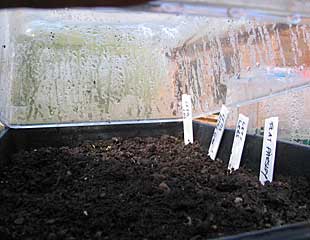
Leggy tomato seedlings
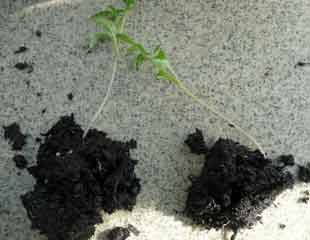
Leggy seedling planted deep
